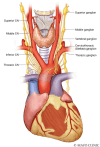Sleep Disruption and Atrial Fibrillation: Evidence, Mechanisms and Clinical Implications
- PMID: 40811503
- PMCID: PMC12352572
- DOI: 10.1161/CIRCRESAHA.125.325612
Sleep Disruption and Atrial Fibrillation: Evidence, Mechanisms and Clinical Implications
Abstract
Atrial fibrillation (AF) is the most prevalent sustained cardiac arrhythmia, with its incidence rising due to aging populations, obesity, and advancements in diagnostic modalities. The interplay between sleep disorders and AF is increasingly recognized, with obstructive sleep apnea (OSA) serving as a well-established risk factor. However, emerging evidence implicates additional sleep disturbances-including central sleep apnea, insomnia, and restless legs syndrome-in AF pathogenesis and progression. Despite compelling observational data, interventional studies evaluating the impact of sleep disorder treatment on AF outcomes have yielded mixed results. Although continuous positive airway pressure therapy in patients with OSA mitigates AF recurrence, randomized controlled trials have yet to confirm a definitive causal benefit. This review synthesizes epidemiological, mechanistic, and interventional data linking sleep disorders to AF.
Keywords: atrial fibrillation; continuous positive airway pressure; heart failure; sleep apnea, central; sleep apnea, obstructive.
Conflict of interest statement
A. Deshmukh consulted for GE Healthcare; V.K. Somers serves on the Sleep Number Scientific Advisory Board and as a consultant for Lilly, Jazz Pharmaceuticals, ApniMed, iRhythm, Mineralys, and Axsome. Y. Dauvilliers received funds for seminars, board engagements, and travel to conferences from Avadel, Bioprojet, Idorsia, Jazz Pharmaceuticals, Centessa, and Takeda. The other author reports no conflicts.
Figures






Similar articles
-
The impact of continuous positive airway pressure therapy on the recurrence of atrial fibrillation in patients with obstructive sleep apnea after pulmonary vein isolation.BMC Cardiovasc Disord. 2025 Jul 4;25(1):473. doi: 10.1186/s12872-025-04846-x. BMC Cardiovasc Disord. 2025. PMID: 40615775 Free PMC article.
-
Treating obstructive sleep apnea with continuous positive airway pressure reduces risk of recurrent atrial fibrillation after catheter ablation: a meta-analysis.Sleep Med. 2018 Jun;46:5-11. doi: 10.1016/j.sleep.2018.02.013. Epub 2018 Mar 22. Sleep Med. 2018. PMID: 29773211
-
Systematic and opportunistic screening for atrial fibrillation and other arrhythmias in patients with obstructive sleep apnea: a prospective, single-center, cross-sectional study.Ther Adv Chronic Dis. 2025 Aug 23;16:20406223251348336. doi: 10.1177/20406223251348336. eCollection 2025. Ther Adv Chronic Dis. 2025. PMID: 40860608 Free PMC article.
-
Impact of continuous positive airway pressure therapy on restless legs syndrome in patients with coexistent obstructive sleep apnea: A qualitative systematic review.J Clin Neurosci. 2025 Mar;133:111075. doi: 10.1016/j.jocn.2025.111075. Epub 2025 Jan 28. J Clin Neurosci. 2025. PMID: 39879879
-
Impact of Long-Term CPAP Adherence on Recurrence After Atrial Fibrillation Ablation in Patients With Severe Sleep Apnea.J Am Heart Assoc. 2025 May 20;14(10):e038742. doi: 10.1161/JAHA.124.038742. Epub 2025 May 15. J Am Heart Assoc. 2025. PMID: 40371580 Free PMC article.
References
-
- Peppard PE, Young T, Palta M, Skatrud J. Prospective study of the association between sleep-disordered breathing and hypertension. N Engl J Med. 2000;342:1378–1384. doi: 10.1056/NEJM200005113421901 - PubMed
-
- Deshmukh AJ, Asirvatham SJ. Atrial fibrillation: embracing the unknown. JACC Clin Electrophysiol. 2018;4:228–230. doi: 10.1016/j.jacep.2017.11.016 - PubMed
-
- Schnabel RB, Yin X, Gona P, Larson MG, Beiser AS, McManus DD, Newton-Cheh C, Lubitz SA, Magnani JW, Ellinor PT, et al. 50 year trends in atrial fibrillation prevalence, incidence, risk factors, and mortality in the Framingham Heart Study: a cohort study. Lancet. 2015;386:154–162. doi: 10.1016/S0140-6736(14)61774-8 - PMC - PubMed
Publication types
MeSH terms
LinkOut - more resources
Full Text Sources
Medical

